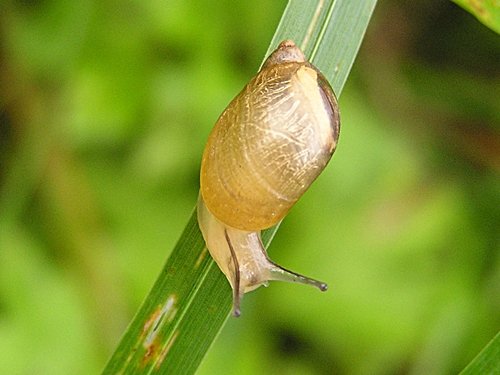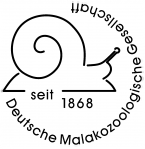
Of all terrestrial snails, amber snails (Succinea) live nearest to water. Picture: [RN]
 Of all terrestrial snails, amber snails (Succinea) live nearest to water. Picture: [RN] |
Generally, snails are looked at with disgust. Gardeners are particularly unfriendly towards their slimy cohabitants and everything thinkable (and some things unthinkable) is done to get rid of them.
Too few people take into account that the world of snails has many interesting secrets to reveal:
So for example, a snail can crawl over a knife's edge without hurting itself. Snails can go over water - well, at least they can crawl hanging from its surface.
There are venomous snails, which kill their prey using a harpoon tooth, and others which besiege a mussel, until it opens its shell. Predator snails hunt their prey following its scent, through rivers and up trees, until the prey has fallen. Sea-living slugs eat jellyfish, only to collect their nettle cells and to use them for their own defence.
Angel-like translucent snails swim through the sea and eat other snails, which catch their plankton prey with a net. Themselves they are eaten by fish and whales and so are an important link in the ocean's food chain. There is a marine predator slug which eats other snails without a tooth in its mouth.
There are 43,000 gastropod species on our earth today, measuring between a millimetre and 75 centimetres. Snails not only live on land, but also in freshwater and in the sea. There are colourful sea slugs among them, as well as cowry shells, which have been money in Africa for centuries.
The neurobiology of learning was researched using snails.
Only a very little part of them is edible or a garden pest. Much more there are numerous snail species in our gardens, which not only are not pests but even are quite useful, in that they eat other snails or their eggs, they return wilted plant parts to the circulation of nature or they help in the manufacture of compost.
It has been the goal of this homepage for ten years to acquaint you with this fascinating animal group, and to wake your interest for a world, which often enough takes place in the hidden.
![]() List of printed publications of Robert Nordsieck.
List of printed publications of Robert Nordsieck.

German Malacozoological Society
"I just had a look at your mollusc page and you have a great reference website. Nice work." - Dave Harasti (http://www.daveharasti.com).
| One glimpse on snails: | |
 A Roman snail (Helix pomatia), the largest native land snail. Picture: Martina Eleveld. |
|